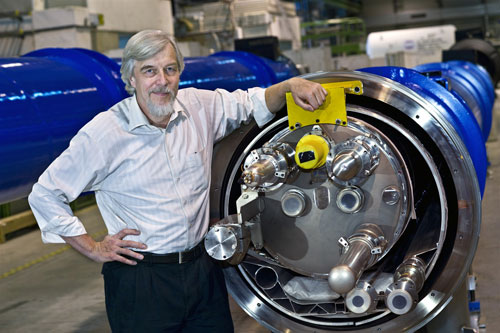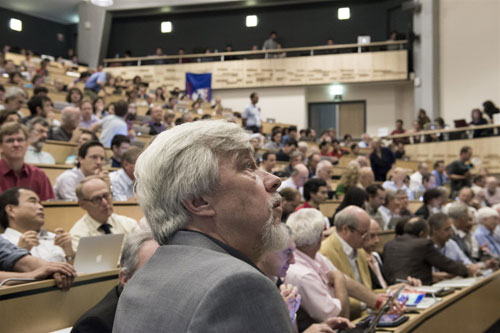
All in a day’s work. (Courtesy: CERN)
By Rolf-Dieter Heuer, Geneva
There is no such thing as a typical day in the life of a CERN director-general (DG), certainly not this one in any case. In my experience, each incumbent has carved out a slightly different role for themself, shaped by the laboratory’s priorities and activities at the time of their mandate. For me, every day goes beyond science, management and administration, and I am particularly fortunate to have been DG through a remarkable period that has seen not only the successful launch of the Large Hadron Collider (LHC) and confirmation of the Brout–Englert–Higgs mechanism, but also an opening of CERN to the world – an area that I have pursued with particular vigour.
As I regularly joke, we have changed the “E” of CERN from “Europe” to “Everywhere”, and that has meant a lot of travel for the CERN DG, as we hold discussions with prospective new members of the CERN family. And when the CERN Council opened up membership to countries from beyond the European region in 2010, it seemed to me that we should also be extending our contacts in other directions as well.
For that reason, I have taken up the CERN DG’s standing invitation to attend the World Economic Forum’s annual meeting in Davos, where I strive to get science further up the agenda, and I have actively pursued a policy of engagement with other international organizations. CERN’s host city is home to a concentration of international organizations like nowhere else on Earth, and our missions overlap in areas ranging from technology to standards to intellectual property. A typical day might see me paying a visit to the United Nations Office in Geneva, or receiving a visit from the ambassador of an existing or prospective CERN member state.
But the role goes beyond one of diplomacy. The CERN DG has, first and foremost, a lab to run. Although I have a strong team of directors and department leaders to help me, issues ranging from liaison between experiments to delicate issues in human resources or dealings with officials from our two host states – France and Switzerland – find their way to my door. Each year is punctuated by fixed points for the meetings of advisory and governance bodies, for directorate meetings and presentations to personnel.
With all this going on, there is no typical day, so I’ll describe the most untypical of all during my term of office: Wednesday 4 July 2012.
I’d been told that people were so keen to have a seat in CERN’s main auditorium for that day’s Higgs-update seminar that some were prepared to camp out all night to secure their place, so I came in early to see if it were true. I expected to see a few hardy souls at 7 a.m., but not the long snaking queue, headed up by sleeping bags, that started outside the doors of the auditorium, carried on all the way along corridors and ended up down the stairs in main entrance lobby. The atmosphere was reserved, yet excited, with an air of expectation about it. I went up to my office to prepare my notes and gather my thoughts.
We had not known until the last minute whether or not we would be announcing a discovery or just another step on the way. Yet the world was expectant. Peter Higgs and François Englert were at CERN, as were Gerry Guralnik and Carl Hagen – two of the three authors of the other pioneering paper from the 1960s that had anticipated what we now know as the Brout–Englert–Higgs mechanism. Robert Brout, unfortunately, did not live to see the confirmation of his ideas, while Tom Kibble – Guralnik and Hagen’s co-author – was at a parallel event in London. The press were also there in force, and the CERN Council’s meeting room was converted into a media centre for the day.
Although just a few days earlier I didn’t know what message I’d be bringing to the expectant crowd, at 7 a.m. that day I had what I needed to announce a discovery. Over the preceding weeks and days, Fabiola Gianotti and Joe Incandela had each kept me up to date with the status of the analyses from the ATLAS and CMS experiments of which they were the spokespersons, and by the Friday before the seminar, I’d seen enough. Although by that time neither experiment was sure they’d be able to announce the required 5σ significance needed to claim discovery, I’d seen both experiment’s results, and that was enough for me to know that taken together the 5σ would be reached.

Wednesday 4 July 2012 was an extraordinary day. (Courtesy: CERN)
By the time I went back down to the auditorium, the doors had been opened and people had taken their seats, yet the crowd outside seemed even bigger than before. Inside the room, the mood was an unusual mixture of party and scientific seminar. We were being watched around the world: nearly half a million people tuned in to the webcast, I’m told, and we had a room full of physicists in Melbourne assembled there on the eve of that year’s major particle-physics conference, beamed to a screen above my head. It culminated in joyous scenes as the experiments announced their results: as it turned out, they didn’t need me to announce the discovery. Peter Higgs, sitting next to François Englert whom he’d met for the first time that day, had a smile on his face that said it all.
The seminar was over, but for me the day was just beginning. Fabiola, Joe and I were ushered into the media centre for a press conference, in which the theorists were given a front-row seat. Once the media scrum has subsided and Peter Higgs had graciously led the theorists in saying that this was a day for the experiments and there’d be time to talk to him later, the three of us recounted the story all over again before spending the day giving interview after interview.
Eventually, the cameras stopped clicking, the microphones were put back in their bags, and it was time to head off for the airport to catch my flight to Melbourne for the conference. It was only when I got on the plane and ordered a glass of champagne that the enormity of the day sunk in. It had been an incredible day, full of emotion, leaving me happy not only with the result, but also with that fact that it had so strongly captured the world’s imagination.
A day in the life of the CERN DG? Always challenging, sometimes exhausting, frequently frustrating but always rewarding. And although 4 July 2012 may not have been a typical day, it is for me one of the most memorable of all.
* For more on what the job of CERN DG involves, read “Leadership required” by Sharon Ann Holgate from the September 2014 issue of Physics World magazine, which includes interviews with former lab bosses Christopher Llewellyn Smith and Herwig Schopper.
CERN has done a wonderful job, particularly,
in the discovery of the Higgs boson. It has inspired many physicists even here in remote parts of Africa
Trackback: Physics Viewpoint | A day in the life of CERN’s director-general
Trackback: Blog - physicsworld.com
Trackback: Blog - physicsworld.com